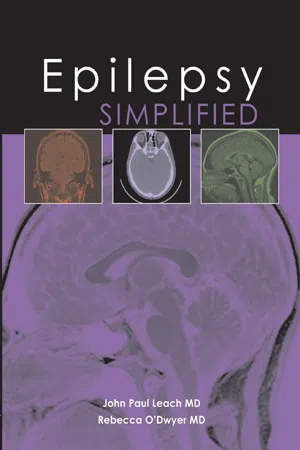![]()
Chapter 1
Definition and epidemiology of epilepsy
What is epilepsy?
Definitions
Epilepsy is a very variable disorder. To help form an image in your mind, it may be helpful to define various seizure manifestations and aspects of the disease. Things might at first seem rather complex when we start by saying that while all patients with epilepsy experience seizures at some point, not all patients with seizures have epilepsy. Bear with us, it’ll be less complex than you think!
Epileptic
This is a word which shows that something is caused by or related to epilepsy. Given the stigma, it has become politically incorrect to use it as a single word to describe a patient. Actually while I usually find PC phrases jarring, I completely agree with this - it should go the way of other terms which have evolved a derogatory undertone (e.g. ‘mental’, ‘cretin’, ‘banker’). The acceptable term is ‘patient with epilepsy’.
Epileptic seizure
An epileptic seizure is a clinical manifestation resulting from abnormal and excessive electrical discharges in a set of neurones within the brain. This may involve alteration of consciousness, alongside motor, sensory, autonomic or psychic events, that can be perceived by the patient or an observer. In other words, seizures cause signs, or symptoms, or both.
Acute symptomatic seizure
Acute symptomatic seizures are an immediate response to any form of brain insult, whether traumatic, systemic, toxic or metabolic in nature. They may be referred to in the literature as a ‘provoked seizure’ or ‘situation-related seizure’. Evidence would suggest that having an acute symptomatic seizure does not lead to an increased risk of future spontaneous seizures.
Unprovoked single seizure
An unprovoked single seizure is any seizure (or cluster of seizures occurring within 24 hours), in a person older than one month of age and in the absence of any precipitating factors or possible responsible clinical condition. After a single event (see section on single seizures later) only around half of patients will have a spontaneous recurrence. There are therefore good prognostic and therapeutic reasons for separating out patients having a single seizure from those with a diagnosis of epilepsy. Unprovoked seizures may result from a static brain injury (e.g. cerebral ischaemia, trauma) or a progressive (not acute) injury (e.g. tumour, degenerative disorder). There is an increased risk of recurrence of a single seizure in patients with an underlying brain injury.
Provoked seizure
A seizure with a specific and isolated cause (e.g. immediate aftermath of a head injury, stroke, alcohol withdrawal).
Epilepsy
Now we get to the easy part. Once there have been two or more unprovoked seizures (see above) then the patient is deemed to have epilepsy. Because the prognosis of recurrence differs in patients who have had febrile seizures and neonatal seizures (<1 month of age), these two groups are excluded from this definition.
Epileptic syndrome
Syndromic diagnosis of epilepsy (see later section) tries to group types of epilepsy according to type of seizures and source of discharges. For example, if the epilepsy arises from the frontal lobes then the epilepsy syndrome is said to be a frontal lobe epilepsy. Discussion will follow later on the classification of epilepsy and seizures (bet you just can’t wait!).
Seizure semiology
The symptoms and signs noted directly before, during and directly after a seizure.
Status epilepticus
A single epileptic seizure of longer than 30 minutes or a cluster of epileptic seizures lasting for 30 minutes or longer during which the patient has not regained their baseline level of functioning.
Ictal
Ictal is an adjective describing the period of time during any attack (or for the purpose of this book usually an epileptic seizure), e.g. post-ictal drowsiness, ictal spitting.
Interictal
Interictal is an adjective describing the periods of time in between epileptic seizures.
Epidemiology of epilepsy
Epilepsy is a common disease that occurs worldwide and affects patients of any age. It is estimated that the annual incidence of epilepsy is approximately 80 cases per 100,000 people, with development of chronic epilepsy resulting in a prevalence of around 0.5% (Table 1). The incidence varies with age, the majority of newly diagnosed patients being at the extremes (either under 2 years of age or older than 65 years). Annually, about 20 people per 100,000 will have an isolated seizure. The estimated risk of developing epilepsy over a lifetime (the ‘cumulative incidence’) ranges from 3 and 5%.
A higher prevalence of epilepsy is seen in underdeveloped areas, especially where cysticercosis is endemic. Similarly, epilepsy is more common in lower socio-economic classes, perhaps due to poorer perinatal care, nutrition and hygiene, in addition to exposure to a greater risk of brain injury and cerebral infection. There is no marked gender preference, but males have a slightly higher risk of being diagnosed with epilepsy.
Within 5 years of onset of seizures, 50-60% of patients will enter a long period of remission on starting treatment, many having long-term control. Up to 30% of patients will eventually develop medically refractory epilepsy despite multiple anticonvulsant medication trials. Given the need for ongoing monitoring and possible trials of further drug combinations, this 30% forms a disproportionately large number of the cohort ...
